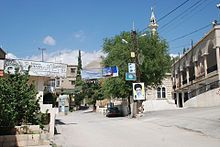Temnine el-Faouqa
| Temnine el-Faouqa | ||
| State : |
|
|
| Governorate : | Bekaa | |
| Coordinates : | 33 ° 54 ' N , 35 ° 59' E | |
| Height : | 1100 m | |
| Time zone : | UTC + 2 | |
|
|
||
Temnine el-Faouqa , Arabic تمنين ألفوقا, Temnine al-Fawqa, Tamnine; is a village on the western edge of the Bekaa plain in Lebanon . A nymphaeum from Roman times has been preserved above the village .
location
Temnine el-Faouqa is located in the Zahlé district within the Bekaa governorate . The place is about 1,100 meters above sea level in a valley cut on the eastern slope of the Jebel Sannin, the summit of which, at 2,682 meters, is the highest point in the southern Lebanon Mountains . This mountain range descends to the Bekaa plain in partly steep hills between fragmented valleys. The villages in the valley basins can only be reached from the plain on cul-de-sac. In the neighboring side valley to the south lies the village of Niha , in the mountains above the Roman pilgrimage destination Hosn Niha , and in the northern valley the village of Qsarnaba . Temple ruins from Roman times have been preserved in these neighboring towns.
From Zahlé the western of the two roads to Baalbek leads about eight kilometers in a north-westerly direction along the foot of the mountains. At a new street settlement, a side street branches off to the left, which reaches the village after 1.5 kilometers. As in the neighboring towns, mainly grapes are grown on the flat slopes.
Townscape
In contrast to the Christian Niha, Temnine el-Faouqa has almost exclusively Shiite residents. The place is controlled by local members of Hezbollah . The access road ends at the center square. This is where the school and the Al-Husseinieh mosque are located. Below the place grows with new buildings along the street, above the square narrow, winding streets lead through the older part of the town. The population was estimated at 300 to 400 in the 1930s; in 2010 it was likely to be over 1000.
Roman well sanctuary
One kilometer above the village along a narrow road leading steeply into the mountains, the Nymphaeum is located in a small, protected pine and cypress forest. It is called Ain el-Jeb ("source of the well") in Arabic . The sanctuary was partially built into the steep slope above a stream. It consists of a small barrel-vaulted room with a four-meter-deep shaft in the center of which is bricked vertically downwards. This bends backwards at the bottom and is usually filled with groundwater, at least in winter and spring.
The inner walls consist of four layers of massive, roughly hewn cuboids right up to the vault. The top layer is completed by an unfinished cornice. At the rear end a slightly raised platform has been preserved as an Adyton . In the small semicircular niche on the back wall there was probably an image of the deity. It was probably a local deity of flowing water, which can be seen in a badly weathered state on a stone slab.
A vestibule in the form of an ante was added to the vaulted space , which ended with an architrave with three fascias (horizontal stripes) and an upper bulge. The staircase leads up in the middle between two columns with Corinthian capitals that support the architrave. The porch is heavily restored, the rectangular portal was made of concrete. Only the arch and two rows of stone on the side walls were preserved before the restoration. The stone blocks of the side walls were piled up again, the columns and capitals are largely new. Longitudinal grooves can be seen on the top of the vault. They may have served as a support for a wooden roof.
literature
- Daniel Krencker , Willy Zschietzschmann (Ed.): Roman temples in Syria. After recordings and investigations by members of the German Baalbek expedition 1901–1904 and own recordings in 1933 (= Monuments of ancient architecture. 5, text volume, ZDB -ID 535277-0 ). Text tape. de Gruyter, Berlin et al. 1938, pp. 138-140.
Web links
Individual evidence
- ↑ Krencker, Zschietzschmann (ed.): Roman temples in Syria. Text tape. 1938, p. 138.
- ^ Karl-Heinz Bernhardt : The old Lebanon. Koehler & Amelang, Leipzig 1976, Fig. 87.


